
July 2005

Frieda Remembered
mild mannered but passionate
the most determined person I ever knew
tired but tireless
she never gave up
loving but tough
humble but well-known
and her smile lit up her face
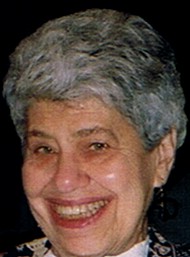 |
| Frieda Zames Photo by Fusun Ateser |
I so wanted to call her after her memorial service on June 19th and say, "Frieda, guess who I saw today, someone you haven’t seen in several years!"
She would have delighted in the fact that so many people came together, but she would have wondered why all the fuss was about her. She probably would have assumed that only her family and a few close friends would attend her formal memorial service. So many people felt close to Frieda. She had a way of making us all feel like her close friend. And the fact that there were obituaries about her in the New York Times, the Sun, and Newsday would have floored her as she never seemed to think of herself as famous or influential.
 |
| Frieda reading from their book with her sister Doris Photo by Philip Bennett |
Several hundred people with and without all kinds of disabilities came to Frieda’s memorial service, and probably fifty were in wheelchairs and scooters. At the service, Doris Zames Fleischer, Frieda’s sister and co-author of their book, The Disability Rights Movement: from Charity to Confrontation,
talked about Frieda’s early life after Frieda contracted polio at age 2 ˝ and lived apart from her family in institutions for almost all of the next 10 years.
Frieda was an amazing woman. Her early education was spotty because of low academic expectations of children with disabilities and poor teaching in hospitals and "convalescent homes,"
where children with disabilities were sent. She had many early surgeries. But Frieda eventually lucked out and got a good teacher who realized her potential. It happened this way: Frieda would get a week’s worth of homework from the teacher and she realized at a young age that if she did it all on Monday, she would have the rest of the week to read whatever she wanted in the library. The teacher found out and gave Frieda more work, really challenging her.
Frieda was smart in every school subject, but excelled in math, and instead of isolating her, it made her popular because she could help other kids, especially when she got out of the institutions and lived at home and went to public school.
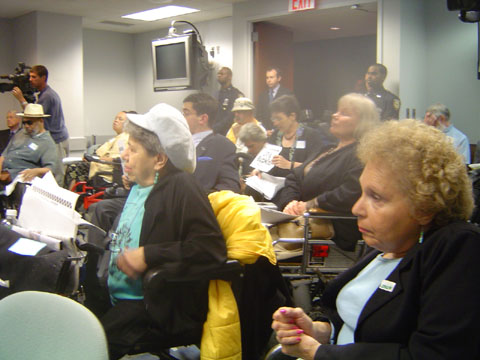 |
| Frieda (pictured left-of-center, with hat) in group at a TLC hearing Photo by Philip Bennett |
Frieda earned her undergraduate degree from Brooklyn College. She was using crutches then and her mother went to college with Frieda to carry her books for her. The college was inaccessible and Frieda had to laboriously and precariously go up two steps to get into the buildings. It never occurred to her at that time that she had a right to access without steps.
In the seventies, Frieda’s thinking changed, and she became a champion of disability rights when she wasn’t teaching college math at New Jersey Institute of Technology. She had earned a Ph.D. in math at New York University by working during the day at an office job and going to school nights.
No longer was her disability and lack of access her own problem to deal with. It became a civil rights issue that was a societal problem, not just hers alone. Buildings should be made accessible to everyone instead of excluding people. She was instrumental in making her campus wheelchair accessible. Buses should be made accessible to everyone, not just people who could easily walk onto them, and New York City bus access was an early project that Frieda got involved in.
When Frieda got a car with hand controls, it gave her freedom to participate in society and have an active social life. She could go out of the city and to other boroughs with ease. Eventually, she would give up her crutches and use a scooter for mobility. Frieda delighted in her ability to speed around the sidewalks of New York, get on and off buses, and go where she needed to go, but she also continued to drive until about a year ago when she reluctantly gave up her car. Not having a car was frustrating because with limited and slow bus service, and no meaningful accessible taxi service, she could not easily go to other boroughs or out of the City to visit friends or family and attend music festivals and The DIA Singers’ practice.
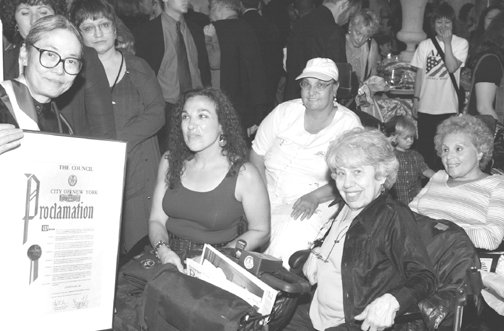 |
| Frieda (pictured right-of-center) smiling with other activists Photo by Philip Bennett |
DIA (Disabled In Action) was Frieda’s passion and she was very involved in every aspect of DIA. So many people found out about DIA through Frieda. Besides inviting many new people to attend DIA meetings, Frieda found people to do jobs within DIA , represent DIA at meetings and hearings, and write for the newspaper. If no one volunteered for a job, she would volunteer to do it on top of everything else she did. She regularly attended many meetings and hearings, sometimes three in one day.
Frieda and Robert Levine founded The One-Step Program, a program in cooperation with the NYC Commission on Human Rights to eliminate the barriers of single steps into doctors’ offices, restaurants, stores, and office buildings (housing barrier complaints go straight to the Commission). That program is still going on in DIA (see our website – www.disabledinaction.org). Among many other initiatives, Frieda was instrumental in Ferries for ALL and the Taxis For ALL Campaigns and was active in them at the time of her death. Senior issues, healthcare, and housing issues occupied her time, too. She was an active member of the Disabled In Action Singers. Frieda had been president of DIA more than once, and at the time of her death she was Vice President for Legislative Affairs. She volunteered on the CIDNY (Center for Independence of the Disabled in New York) board and the WBAI (Pacifica Radio) board, too, and was very involved in NYSILC (New York State Independent Living Council).
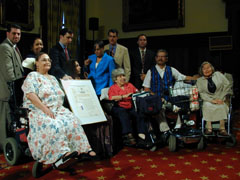 |  |
| Reading the ADA Proclamation Photo by Philip Bennett | Frieda getting a Proclamation from Speaker Miller and CM Lopez Photo by Philip Bennett |
One of Frieda’s great skills was her ability to bring people together to work on something or simply to have fun. She made so many friends.
We need to turn our grief into action. For Frieda’s sake, our own, and others’, we need to continue the struggle for disability rights. We need to put in One-Step Complaints (go to www.disabledinaction.org to make a complaint). We need to continue to work for accessible ferries and taxis. We need D-SCRIE (senior citizens’ rent increase exemption for people with disabilities) and more accessible housing. We need affordable health care and medications. We need access to healthcare through accessible exam tables and equipment.
Frieda did not give up. She remained optimistic that positive change would happen with time and hard work.
 | 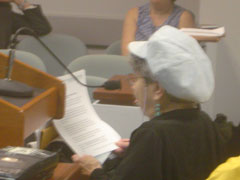 |
Frieda telling Speaker Miller, "We need accessible taxis" Photo by Philip Bennett | Frieda testifying about accessible taxis at a TLC hearing Photo by Philip Bennett |
Frieda is survived by her partner of 34 years, Michael Imperiale. Frieda’s sister, Doris, her brother-in-law, Leonard Fleischer, niece Abby Fleischer, and nephew Joseph Fleischer also survive her.
By Jean Ryan, whom Frieda brought into DIA, welcomed to the newspaper committee, and then in typical fashion soon invited to be editor. Frieda was my mentor in disability rights after I had become disabled later in life. She took me under her wing as she did many others. Frieda brought me to meetings, introduced me to people, and became my friend.